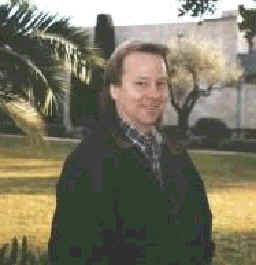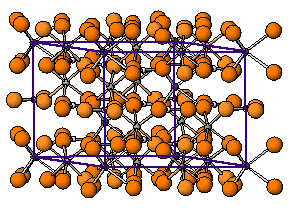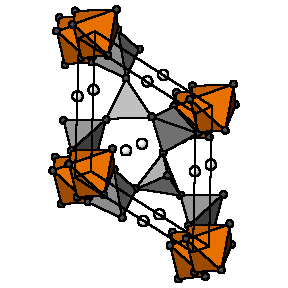

Solid-State Inorganic Chemistry
B.S. SW Oklahoma State University, 1979
PhD. Northwestern University, 1984
Exxon Solid-State Chemistry Award, Alfred P. Sloan
Fellow, F. A. Gilfillan Memorial Award
Our research involves the preparation and characterization of new solid-state inorganic materials. Current efforts are directed to the development and study of laser hosts, nonlinear optical materials, phosphors, transparent conductors, wide band-gap semiconductors, and low-temperature deposition and crystallization of thin films.
 We have synthesized several new families of solid-state borates. As a class of
materials, these compounds exhibit a number of characteristics that make them attractive
for use in high-power laser systems. Such properties include wide windows of transparency, high
optical damage thresholds, moderate crystal-growth temperatures, and unique structural
arrangements. We made the initial discovery of CsLiB6O10
(CLBO,) a nonlinear optical material that provides the highest-power UV laser beam
from a solid-state system. We have also recently established the
necessary conditions for stabilization of trigonal Sc borate huntites, LnSc3(BO3)4
(Ln = lanthanide), which comprise a promising new family of frequency conversion crystals.
Our work in this area has been considerably aided by our development of a simplified
version of the anionic group theory for prediction of nonlinear optical properties.
We have synthesized several new families of solid-state borates. As a class of
materials, these compounds exhibit a number of characteristics that make them attractive
for use in high-power laser systems. Such properties include wide windows of transparency, high
optical damage thresholds, moderate crystal-growth temperatures, and unique structural
arrangements. We made the initial discovery of CsLiB6O10
(CLBO,) a nonlinear optical material that provides the highest-power UV laser beam
from a solid-state system. We have also recently established the
necessary conditions for stabilization of trigonal Sc borate huntites, LnSc3(BO3)4
(Ln = lanthanide), which comprise a promising new family of frequency conversion crystals.
Our work in this area has been considerably aided by our development of a simplified
version of the anionic group theory for prediction of nonlinear optical properties.
Recent synthetic efforts have produced one of the larger structural classes of oxide ever discovered. Designated the STACK family, these materials have the composition A6MM'(BO3)6 where A = Sr, Ba, or selected lanthanides, B = +2 or +3 cation, and M' = +2, +3, or +4 cation. More than 150 derivatives of this new structural type have been prepared. The derivative Sr3Sc(BO3)3 (doped with the ion Cr3+) is currently being examined as a new solid-state laser material, and the luminescence characteristics of several additional doped derivatives are being examined.
 Additional work is directed to the synthesis of new oxide
halides, sulfide halides, and sulfides. Each of these classes of material is being investigated for the production
of new phosphors and transparent conductors. The oxoanion halides are of
interest as hosts for lanthanide ions that exhibit quantum-splitting effects,
i.e., quantum efficiencies >1. Such materials may form the basis for
future lighting technologies. In sulfide work, we have recently
demonstrated exceptional efficiencies in high-field electroluminescent devices
operating on the basis of SrS:Cu,Na and new thin-film, p-type transparent
conductors have been fabricated that exhibit transparency throughout the visible
portion of the spectrum.
Additional work is directed to the synthesis of new oxide
halides, sulfide halides, and sulfides. Each of these classes of material is being investigated for the production
of new phosphors and transparent conductors. The oxoanion halides are of
interest as hosts for lanthanide ions that exhibit quantum-splitting effects,
i.e., quantum efficiencies >1. Such materials may form the basis for
future lighting technologies. In sulfide work, we have recently
demonstrated exceptional efficiencies in high-field electroluminescent devices
operating on the basis of SrS:Cu,Na and new thin-film, p-type transparent
conductors have been fabricated that exhibit transparency throughout the visible
portion of the spectrum.
Recent Publications
Sangmoon
Park and Douglas A. Keszler, “Cation ordering in Langasite structure types,”
Solid State Sciences, in press.
John
F. Wager, John C. Hitt, Beau A. Baukol, Jeffrey P. Bender, and Douglas A. Keszler,
“Luminescent impurity doping trends in alternating-current thin-film
electroluminescent phosphors,” J. Luminescence, in press.
Dhiraj
K. Sardar, Francisco Castano, Joey A. French, John B. Gruber, Thomas A.
Reynolds, Theodore Alekel, Douglas A. Keszler, and Benjamin L. Clark,
“Spectroscopic and laser properties of Nd3+ in LaSc3(BO3)4
host. J. Appl.
Phys. 90, 4997-5001 (2001).
John
B. Gruber, Thomas A. Reynolds, Theodore Alekel, Dhiraj K. Sardar, Bahram Zandi,
and Douglas A. Keszler “Spectra and Energy Levels of Co2+ in Zinc
Oxide Metaborate,” Phys. Rev.B: Condens. Matter Mater. Phys. 64,
04511/1-04511/7 (2001).
Benjamin
L. Clark and Douglas A. Keszler, “Hydrothermal dehydration of precipitates:
convenient synthesis method for solids,” Inorg. Chem. 40,
1724-1725 (2001).
Jennifer L. Stone, Douglas A. Keszler, Gérard Aka, Andrée Kahn-Harari, Thomas
A. Reynolds, “Nonlinear optical borate crystal Ba2B10O17,”
Proc. SPIE-Int. Soc. Opt. Eng. 4268 (Growth, Fabrication, Devices, and
Applications of Laser and Nonlinear Optical Materials) 175-179 (2001).
A.
Lorriaux-Rubbens, G. Aka, E. Antic-Fidancev, D. A. Keszler, and F. Wallart,
“Polarized Raman spectra of the nonlinear and laser crystal Ca4GdO(BO3)3
(GdCOB),” J. Raman Spectrosc. 31, 535-538 (2000).
Dong Li, Benjamin L. Clark, Douglas A. Keszler, Paul D. Keir, and John F. Wager, “Color Control in Sulfide Phosphors; Turning Up the Light for Electroluminescent Displays,” Chem. Mater. 12, 268-270 (2000).
Phone:
541-737-6736